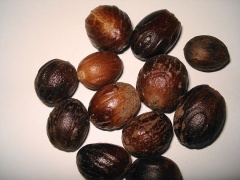Difference between revisions of "Nutmeg"
| Line 18: | Line 18: | ||
==Applications== | ==Applications== | ||
| − | Nutmegs are an important spice and are used for seasoning soups, sauces, vegetables, meat and fish dishes, for liqueur production and for the production of essential oils. | + | Nutmegs are an important spice and are used for seasoning soups, sauces, vegetables, meat and fish dishes, for liqueur production and for the production of essential oils.<br><br> |
| − | <br><br> | + | |
| − | + | ==Storage / transport== | |
Nutmegs are packed in boxes and double-layered jute bags.<br><br> | Nutmegs are packed in boxes and double-layered jute bags.<br><br> | ||
The favourable travel temperature range is 5 – 25°C. At temperatures >25°C, essential oils may be lost. The stowage space should be cool, dry and, most particularly, easy to ventilate. <br><br> | The favourable travel temperature range is 5 – 25°C. At temperatures >25°C, essential oils may be lost. The stowage space should be cool, dry and, most particularly, easy to ventilate. <br><br> | ||
Revision as of 08:47, 26 June 2012
| Infobox on Nutmeg | |
|---|---|
| Example of Nutmeg |  |
| Facts | |
| Origin | This Table shows only a selection of the most important countries of origin and should not be thought of as exhaustive.
|
| Stowage factor (in m3/t) |
|
| Angle of repose | - |
| Humidity / moisture |
|
| Oil content |
|
| Ventilation | If the product is at "shipping dryness", it does not have to be ventilated during transport. However, if the water content does not meet these guidelines, 6 air changes/hour (airing)are recommended to eliminate the potential for dampness. |
| Risk factors | Self-heating / spontaneous combustion, odour sensitivity, contamination, wet damage and mechanical influences; see text. |
Nutmeg
Description
The nutmeg tree is important for two spices derived from the fruit: nutmeg and mace.
The oval nutmegs have a reticulately wrinkled surface and are 2 - 3.5 cm long and up to 2 cm thick. The tissue of the seed kernel is yellowish, with dark strands passing through it which contain the essential oil.
The first harvest of nutmeg trees takes place 7–9 years after planting, and the trees reach full production after 20 years. Nutmeg is usually used in powdered form. This is the only tropical fruit that is the source of two different spices. Several other commercial products are also produced from the trees, including essential oils, extracted oleoresins, and nutmeg butter.
The common or fragrant nutmeg, Myristica fragrans, native to the Banda Islands of Indonesia, is also grown in Penang Island in Malaysia and the Caribbean, especially in Grenada. It also grows in Kerala, a state in southern India. Other species of nutmeg include Papuan nutmeg M. argentea from New Guinea, and Bombay nutmeg M. malabarica from India, called jaiphal in Hindi; both are used as adulterants of M. fragrans products.
Nutmegs (like most spices) are processed, cleaned, graded and packed for overseas dispatch in the countries where they are cultivated. They are dried to preserve them for transport and storage. In consumer countries, they are delivered to spice mills, where they are cleaned and graded again, to be traded in unground or ground form.
Applications
Nutmegs are an important spice and are used for seasoning soups, sauces, vegetables, meat and fish dishes, for liqueur production and for the production of essential oils.
Storage / transport
Nutmegs are packed in boxes and double-layered jute bags.
The favourable travel temperature range is 5 – 25°C. At temperatures >25°C, essential oils may be lost. The stowage space should be cool, dry and, most particularly, easy to ventilate.
Mace is hygroscopic and thus interacts with the moisture in the air. If moisture is present for long periods (>75% relative humidity), mold growth may occur both internally and externally, making the produce musty and brittle (crumbling), leading to considerable loss in value. Excessive moisture may lead to complete loss of commercial value. When wetted, nutmegs should be promptly dried in layers, and if so treated should show no signs due to drying out. The product may be subject to loss in weight and drying out.
Risk factors
- Self-heating / Spontaneous combustion
- Moisture
- Odor
- Contamination
- Mechanical influences
- Toxicity / Hazards to health (mould growth / aflatoxin)
- Shrinkage/Shortage
- Insect infestation / Diseases
Note: (Source including Transport Information Service of the GDV)











